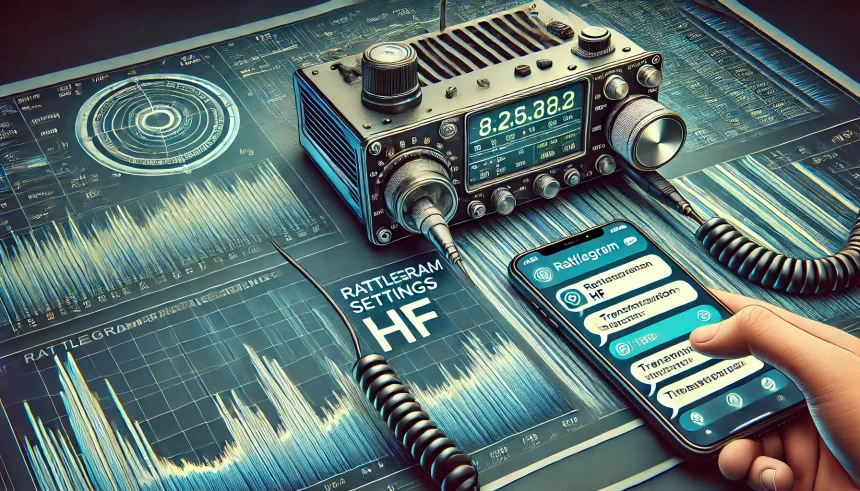Rattlegram settings HF play a crucial role in ensuring smooth and reliable text-based communication over high-frequency (HF) radio bands. This digital messaging system is widely used by amateur radio operators, emergency responders, and remote users who require an alternative to voice communication. By properly configuring the settings, users can maximize efficiency and message clarity.
HF communication allows long-distance transmission, but it can be affected by interference, weak signals, and environmental factors. Adjusting rattlegram settings HF helps overcome these challenges by fine-tuning frequency selection, audio levels, and power settings for optimal performance. The right setup ensures that messages are sent and received accurately.
One of the main advantages of rattlegram settings HF is its ability to function in low-bandwidth conditions. Unlike voice transmission, text-based communication requires less signal strength, making it ideal for weak or unstable connections. Whether for casual use or emergency situations, understanding these settings is essential for seamless operation.
Understanding Rattlegram and HF Communication
Rattlegram is a digital messaging application designed for use with amateur radios. It allows text-based communication over different radio frequencies, including High Frequency (HF) bands. This makes it useful for long-distance communication, especially when voice transmission is not possible.
HF bands range between 3 MHz and 30 MHz, enabling long-range radio communication. Rattlegram takes advantage of these frequencies by converting text messages into audio tones that can be transmitted over the airwaves. The receiving radio deciphers these tones back into text.
One of the biggest advantages of using Rattlegram over HF is its ability to function in low-bandwidth environments. Unlike voice transmissions, text-based communication requires less signal strength, making it ideal for weak-signal conditions.
HF communication can experience interference from atmospheric conditions and other signals. Properly configuring rattlegram settings hf ensures better performance and message clarity. Users must adjust their frequency, audio levels, and power settings to achieve reliable results.
For effective communication, operators should experiment with different settings based on their equipment and transmission environment. Testing with a fellow operator can help optimize performance before relying on Rattlegram for critical communications.
Downloading and Setting Up Rattlegram
Before using Rattlegram, the first step is to download and install the app. It is primarily available for Android devices and requires microphone and speaker access for effective transmission and reception of messages.
Once installed, users must configure the settings according to their radio equipment. Choosing the right frequency, audio levels, and transmission mode is essential for clear message delivery. Incorrect configurations can lead to distorted signals or failed transmissions.
To connect Rattlegram with an HF radio, two primary methods are used:
- Acoustic Coupling – The phone’s speaker and microphone interact with the radio’s microphone and speaker without any physical connection.
- Wired Connection – An audio cable links the phone to the radio, providing a more stable and interference-free connection.
Acoustic coupling is the easiest method since it does not require additional hardware. However, it requires precise alignment of the phone and radio to avoid signal loss. A wired connection is recommended for professional or emergency use.
Users should also test their setup by sending sample messages. This ensures that the selected settings work efficiently under real conditions. Fine-tuning rattlegram settings hf through trial and error helps improve transmission clarity.
Choosing the Right Frequency and Audio Settings
Selecting the appropriate HF frequency is crucial for effective Rattlegram communication. The best frequencies for text-based transmissions typically fall between 500 Hz and 2,500 Hz. These frequencies are within the audio range that most HF radios can handle.
Higher frequencies may not be received properly due to the limitations of the radio’s filtering system. Some radios automatically suppress extreme high or low audio tones, making it essential to stay within the recommended range.
For clear transmissions, the audio input and output levels must be properly adjusted. Too high of an audio level can cause distortion, while too low of a level can lead to missing or unreadable text. Users should gradually adjust the volume settings until they achieve the best clarity.
HF signals can be affected by environmental conditions, such as solar activity and interference from other signals. Regularly testing different frequency ranges can help users determine which settings work best in their area.
Experimenting with power levels can also improve transmission. While higher power settings increase range, they can also cause unwanted interference. Using the lowest power setting necessary for clear communication is ideal.
Sending and Receiving Messages with Rattlegram
Sending a message through Rattlegram is a straightforward process. Users simply type their message into the app and select the transmission frequency. Once the send button is pressed, the app converts the text into audio tones for radio transmission.
The receiving station must be tuned to the same frequency to decode the message. If the audio levels are too high or low, the receiving radio may struggle to interpret the signal, resulting in incomplete or garbled text.
To ensure successful message reception, users should:
- Maintain a clear frequency with minimal interference.
- Adjust volume levels on both transmitting and receiving devices.
- Test their setup with sample messages before relying on it for critical communication.
If messages are not received correctly, adjusting the spacing between words or slowing down the transmission rate can help. Some HF conditions, such as fading or interference, may require multiple attempts to send a complete message.
By fine-tuning rattlegram settings hf, users can ensure smooth text communication. Regular practice and testing improve the reliability of transmissions, especially for emergency and remote operations.
Troubleshooting and Improving Rattlegram Performance
Common issues with Rattlegram include distorted signals, failed message transmissions, and interference from other radio sources. These problems are often caused by incorrect frequency selection, poor audio settings, or external environmental factors.
If a message is distorted, the first step is to check the audio levels. Lowering the transmission volume and adjusting the receiving radio’s gain can help improve clarity.
Interference from nearby signals can also disrupt transmissions. Changing the frequency slightly or using a different HF band can help reduce interference and improve message readability.
For users experiencing frequent transmission failures, switching to a wired audio connection may provide better stability. This eliminates background noise and prevents unintended disruptions caused by environmental factors.
Testing different rattlegram settings hf under various conditions helps users identify the best configurations for their specific setup. Conducting routine performance checks ensures that the system is ready for use when needed.
By addressing these common issues, operators can achieve reliable text-based communication over HF, making Rattlegram a valuable tool for amateur radio enthusiasts, emergency responders, and remote operators.
Conclusion
Rattlegram is a powerful tool for text-based communication over HF frequencies, making it an excellent option for amateur radio operators, emergency responders, and remote users. By properly configuring rattlegram settings hf, users can ensure clear and reliable transmissions, even in challenging signal conditions. The ability to send and receive messages without internet access makes it a valuable addition to any radio setup.
To achieve the best performance, users should experiment with different frequency ranges, audio levels, and transmission power settings. Acoustic coupling is a convenient method for connecting Rattlegram to an HF radio, but a wired connection may provide better stability. Regular testing and fine-tuning of settings are essential for smooth operation.
Troubleshooting common issues like distortion, interference, and failed message delivery helps improve communication efficiency. By continuously optimizing their rattlegram settings hf, operators can maximize the app’s potential and ensure effective text messaging over long distances. With the right setup and practice, Rattlegram can become a reliable tool for HF communication.
FAQs
How do I choose the best frequency for Rattlegram on HF?
Select a frequency between 500 Hz and 2,500 Hz, as most HF radios can handle this range without distortion or signal loss.
Why is my message not being received correctly?
Check if both stations are on the same frequency, adjust audio levels, and reduce background noise or interference for better clarity.
Can I use Rattlegram on HF without a wired connection?
Yes, acoustic coupling allows you to use the phone’s speaker and microphone, but proper alignment is needed for clear transmission.
What should I do if my transmission sounds distorted?
Lower the audio volume on both the phone and radio, as excessive levels can cause overmodulation and make the message unreadable.
How can I improve message reliability in weak signal conditions?
Use minimal power, avoid high interference frequencies, and resend messages slowly to ensure proper decoding by the receiving station.














